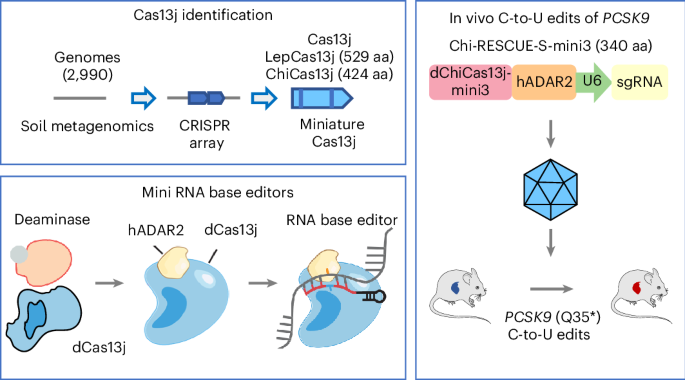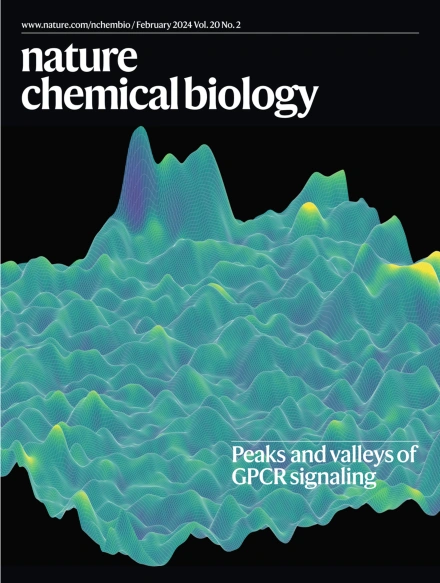Compact RNA editors with natural miniature Cas13j nucleases
IF 13.7
1区 生物学
Q1 BIOCHEMISTRY & MOLECULAR BIOLOGY
引用次数: 0
Abstract
Clustered regularly interspaced short palindromic repeats–Cas13 effectors are used for RNA editing but the adeno-associated virus (AAV) packaging limitations because of their big sizes hinder their therapeutic application. Here we report the identification of the Cas13j family, with LepCas13j (529 aa) and ChiCas13j (424 aa) being the smallest and most highly efficient variants for RNA interference. The miniaturized Cas13j proteins enable the development of compact RNA base editors. Chi-RESCUE-S, by fusing dChiCas13j with hADAR2dd, demonstrates high efficiency and specificity in A-to-G and C-to-U conversions. Importantly, this system is compatible with single-AAV packaging without the need for protein sequence truncation. It successfully corrected pathogenic mutations, such as APOC3D65N and SCN9AR896Q, to the wild-type forms. In addition, we developed an optimized system, Chi-RESCUE-S-mini3, which pioneered efficient in vivo C-to-U RNA editing of PCSK9 in mice through single-AAV delivery, resulting in reduced total cholesterol levels. These results highlight the potential of Cas13j to treat human diseases. Li, Cheng, Yu and colleagues have discovered a Cas13j family, including the compact and highly efficient LepCas13j (529 aa) and ChiCas13j (424 aa), with promising applications in RNA editing in vivo.


带有天然微型 Cas13j 核酸酶的紧凑型 RNA 编辑器
簇状规则间隔短回文重复序列-Cas13效应子可用于RNA编辑,但由于其体积较大,腺相关病毒(AAV)包装的局限性阻碍了它们的治疗应用。在这里,我们报告了 Cas13j 家族的鉴定结果,其中 LepCas13j(529 aa)和 ChiCas13j(424 aa)是最小、最高效的 RNA 干扰变体。小型化的 Cas13j 蛋白使紧凑型 RNA 碱基编辑器的开发成为可能。通过将 dChiCas13j 与 hADAR2dd 融合,Chi-RESCUE-S 在 A 到 G 和 C 到 U 的转换中表现出高效率和特异性。重要的是,该系统与单 AAV 包装兼容,无需截短蛋白质序列。它成功地将 APOC3D65N 和 SCN9AR896Q 等致病突变纠正为野生型。此外,我们还开发了一种优化系统 Chi-RESCUE-S-mini3 ,通过单次 AAV 发送,率先在小鼠体内对 PCSK9 进行了高效的 C 到 U RNA 编辑,从而降低了总胆固醇水平。这些结果凸显了 Cas13j 治疗人类疾病的潜力。
本文章由计算机程序翻译,如有差异,请以英文原文为准。
求助全文
约1分钟内获得全文
求助全文
来源期刊

Nature chemical biology
生物-生化与分子生物学
CiteScore
23.90
自引率
1.40%
发文量
238
审稿时长
12 months
期刊介绍:
Nature Chemical Biology stands as an esteemed international monthly journal, offering a prominent platform for the chemical biology community to showcase top-tier original research and commentary. Operating at the crossroads of chemistry, biology, and related disciplines, chemical biology utilizes scientific ideas and approaches to comprehend and manipulate biological systems with molecular precision.
The journal embraces contributions from the growing community of chemical biologists, encompassing insights from chemists applying principles and tools to biological inquiries and biologists striving to comprehend and control molecular-level biological processes. We prioritize studies unveiling significant conceptual or practical advancements in areas where chemistry and biology intersect, emphasizing basic research, especially those reporting novel chemical or biological tools and offering profound molecular-level insights into underlying biological mechanisms.
Nature Chemical Biology also welcomes manuscripts describing applied molecular studies at the chemistry-biology interface due to the broad utility of chemical biology approaches in manipulating or engineering biological systems. Irrespective of scientific focus, we actively seek submissions that creatively blend chemistry and biology, particularly those providing substantial conceptual or methodological breakthroughs with the potential to open innovative research avenues. The journal maintains a robust and impartial review process, emphasizing thorough chemical and biological characterization.
 求助内容:
求助内容: 应助结果提醒方式:
应助结果提醒方式:


